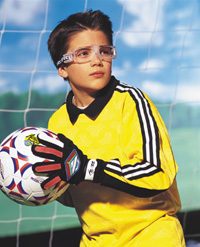The Play Of Life
 In preparation for this months’ SPORTS EYE SAFETY AWARENESS MONTH we read quite a few articles, blogs and social media newsfeed to see what the latest is in the world of Optometry and Ophthmalogy. Now, if you’ve read one, you’ve pretty much read them all when it comes to eye safety and sports. Every parent [for the most part] understands the need to protect their child’s precious sense of sight when it comes to sports activity. But, do we understand the emotion, psychological and mental ramifications when the importance of healthy vision is overlooked.
In preparation for this months’ SPORTS EYE SAFETY AWARENESS MONTH we read quite a few articles, blogs and social media newsfeed to see what the latest is in the world of Optometry and Ophthmalogy. Now, if you’ve read one, you’ve pretty much read them all when it comes to eye safety and sports. Every parent [for the most part] understands the need to protect their child’s precious sense of sight when it comes to sports activity. But, do we understand the emotion, psychological and mental ramifications when the importance of healthy vision is overlooked.
Studies show that only four in ten kids, between the ages of 6-12 years, are actively engaged in neighborhood sports. In addition, studies also an increase in the decline of these numbers in the near future. The lack of mobility and engagement for our children increases their risk for other health related challenges. In America alone, obesity is the number one reason our children become high risk for cardiovascular disease, bone and joint problems, sleep apnea, and social and psychological problems such as stigmatization and poor self-esteem. For most families this is just the beginning.
It seems farfetched and an extreme stretch to see the connection between healthy eye sight and our children’s over well-being. And yet, it [a child’s vision] is usually one of the first signs to alert us there is a deeper issue at hand; especially if your child is active in sports. Like with most things in life, one circumstance has the power to affect all areas of our lives. The same applies for our kids.
However, the signs that your child needs glasses are not always clear. And so, to help you know what to look for, here are a few tips to help you out:
- Tilting their head.This can indicate an eye muscle imbalance.
- Covering one eye/frequent squinting one eye to see the ball either far or near.
- Losing their place in an attempt to catch, throw or follow the ball or apparatus.
- Physical complaints like headaches, watery eyes or dry eyes.
- Problems seeing outdoors, losing sight of the ball, the pitch, especially during quick movement.
- Disruptive behavior during practice/at school, such as talking while the teacher/coach is talking or distracting other students.
These are just a few tips to help you gage your child’s eye health development. Keep in mind, one or two incidents may not be cause for alarm but if you notice a consistency over time, you’ll want to schedule an eye exam just to be sure. And remember, children don’t know the difference between impaired vision and correct vision. They rely on us to catch the signals and notice the signs. When it comes down to it, isn’t it up to us to be team players in protecting their precious sense of sight?
We thought so…game on!


